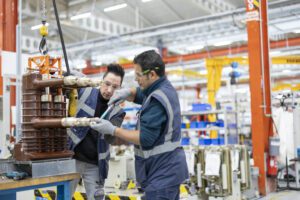I recently had the privilege of speaking at the Standards Council of Canada’s (SCC) World Standards Day celebration, an event that focused on the importance of standards-related activities and honored the efforts of those that give their time to this important work. In support of the global World Standards Day theme: Less waste, better results: Standards increase efficiency – this year’s event honed in on a topic that I consider of high significance in the buildings industry today – the importance of energy efficiency standards.
No doubt you’ve heard about standards before, perhaps with regard to voluntary certification programs such as the U.S. Green Building Council’s Leadership in Energy and Environmental Design (LEED) program, the U.K.’s BRE Environmental Assessment Method (BREEAM), Australia’s Green Star program, and France’s High Quality Environmental Standard (HQE), or perhaps ISO50001. All of these programs are extremely valuable and directly involved in helping us create more efficient buildings, providing a glimpse into what’s possible. Most of these high profile certification systems have been around long enough to have proven economic value in terms of higher building lease rates, asset value, and lower operational costs. However, they are nowhere near “business as usual” or mainstream.
In fact, during Greenbuild in 2011, Rick Fedrizzi, the president, CEO and founding chair of the U.S. Green Buildings Council, stated that LEED was responsible for transforming $100 billion worth of commercial and residential space. With this, he also noted that another $10 trillion in inefficient, “carbon-hungry” real estate around the world exists and has yet to be retrofitted. In his opening plenary speech, Fedrizzi described a world where LEED becomes embedded in mandatory buildings standards, enabled by financial incentives, led first by government and then spreading across all industries around the globe. In closing, Fedrizzi remarked on his vision of a time when the USGBC could close its doors because all buildings were green and energy efficient. Business as usual.
Here’s the good news. We can build super high performance buildings today – beyond LEED or BREEAM, or any voluntary standard. In my role at Schneider Electric and my work with green buildings, I’ve witnessed incredible positive energy and net-zero carbon projects being successfully delivered in an economically viable way that allow building owners and facility managers to run their operations more efficiently while saving on operational costs – kudos to these incredible achievements! However, these types of projects are almost always heroic efforts, led by pioneers that are willing to “figure it out,” trudging through the unknown, trying new technologies, creating new processes, and breaking down existing barriers through sheer dedication and hard work. Given the efforts required for these projects, we can all appreciate that these are not “business as usual” or mainstream … yet.
There is still much work to be done all over the world in ensuring that our buildings are optimized for performance, both in the way they are designed and operated. While not all of the answers are clear, what is apparent is that continued innovation is required. Our planet is currently facing an unprecedented energy challenge, with global demand growing faster than current production capacity, resulting in diminishing supplies and increasing prices. With buildings accounting for 40 percent of energy use in most countries (and more in most cities), it is crucial for industry experts, companies that are intimately involved in creating energy solutions like Schneider Electric, academics and governments to come together to drive the processes and practices into standards that pave the path for a more sustainable future.
It’s my experience that pioneers make their own path and fast followers make their way through the bumps in the mud, but a vast majority of people, including industry players that build, retrofit and maintain the places where we live, work and play, don’t like bumps or mud or new paths. They need standard, repeatable, economically viable practices that scale before they’ll choose to travel the road that leads to a high performance building.
While certification programs scratch the surface in generating a process for creating more efficient buildings, many do not consistently deliver operational performance. For example in 2009, the U.S. Green Building Council (USGBC) realized that over half of the buildings it certified through 2006 were no longer achieving EnergyStar™ label status based on measured energy consumption.
Building performance also degrades over time if continuous commissioning and improvements are not implemented. Measured evaluation and management is a crucial piece of achieving ongoing energy efficiency, as it takes into account the actual operation of the building, behavior and number of occupants, incorrect settings and more, versus simply estimating what those numbers could or should be. These indicators allow building owners and facility managers to constantly adjust energy settings based on data, measurements and calculations to maintain and improve the efficiency of their building. However, this type of rigor is not required to achieve (or keep) most of today’s global buildings standards and certification programs.
While there has been some recent progress to move towards these practices, we must continue to work together to pave this path in order to achieve greater efficiency and performance from our buildings, homes and communities. Schneider Electric participates in the continuing development of standards programs such as USGBC LEED, ZigBee®, and ISO 50001 to name a few, with the belief that over time these collaborations will help to make buildings better. By “better,” we mean not just more efficient and advanced – but easier to run, cheaper to maintain and providing occupants with a better end user experience. Standards help us pave the path, and energy efficiency is something that we can all focus on now.
Do you think that standards are important for creating high performance buildings? What are some of the successful approaches you’ve implemented in your buildings achieve continued efficiency? Leave a comment and let us know! You can also find me on Twitter at @melissaomara.
Learn more about Schneider Electric Green Buildings Solutions.



